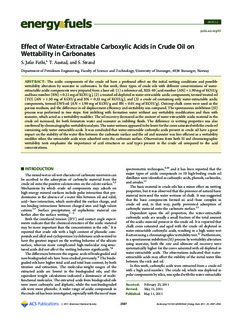| dc.contributor.author | Fathi, Seyed Jafar | |
| dc.contributor.author | Austad, Tor | |
| dc.contributor.author | Strand, Skule | |
| dc.date.accessioned | 2013-07-23T12:23:41Z | |
| dc.date.available | 2013-07-23T12:23:41Z | |
| dc.date.issued | 2011 | |
| dc.identifier.citation | Fathi, S J., Austad, T., Strand S. (2011) Effect of water-extractable carboxylic acids in crude oil on wettability in carbonates. Energy & Fuels 25(6), pp. 2587–2592 | no_NO |
| dc.identifier.uri | http://hdl.handle.net/11250/183212 | |
| dc.description | Reprinted (adapted) with permission from Fathi, S J., Austad, T., Strand S. (2011) Effect of water-extractable carboxylic acids in crude oil on wettability in carbonates. Energy & Fuels 25(6), pp. 2587–2592. Copyright (2011) American Chemical Society. The article forms part of the Jafar Fathi's PhD thesis : Fathi, J. (2011) Water-Based Enhanced Oil Recovery (EOR) by "Smart Water" in Carbonate Reservoirs. University of Stavanger. | no_NO |
| dc.description.abstract | The acidic components of the crude oil have a profound effect on the initial wetting conditions and possible wettability alteration by seawater in carbonates. In this work, three types of crude oils with different concentrations of water-extractable acidic components were prepared from a base oil: (1) a reference oil, RES-40 [acid number (AN) = 1.90 mg of KOH/g and base number (BN) = 0.51 mg of KOH/g], (2) a treated oil depleted in water-extractable acidic components, termed treated oil (TO) (AN = 1.50 mg of KOH/g and BN = 0.53 mg of KOH/g), and (3) a crude oil containing only water-extractable acidic components, termed EWS-oil (AN = 1.90 mg of KOH/g and BN < 0.01 mg of KOH/g). Outcrop chalk cores were used as the porous medium, and the difference in oil displacement efficiency and wettability was compared. The spontaneous imbibition (SI) process was performed in two steps: first imbibing with formation water without any wettability modification and then with seawater, which acted as a wettability modifier. The oil recovery decreased as the content of water-extractable acidic material in the crude oil increased, for both formation water and seawater as imbibing fluids. The difference in wetting properties was also confirmed by chromatographic wettability analysis. The water wetness appeared to be lower for the cores saturated with the crude oil containing only water-extractable acids. It was concluded that water-extractable carboxylic acids present in crude oil have a great impact on the stability of the water film between the carbonate surface and the oil and seawater was less efficient as a wettability modifier when the extractable acids were adsorbed onto the carbonate surface. Observations from both SI and chromatographic wettability tests emphasize the importance of acid structures or acid types present in the crude oil compared to the acid concentrations. | no_NO |
| dc.language.iso | eng | no_NO |
| dc.publisher | American Chemical Society | no_NO |
| dc.relation.ispartof | Jafar Fathi (2011) Water-Based Enhanced Oil Recovery (EOR) by "Smart Water" in Carbonate Reservoirs. PhD thesis UiS. University of Stavanger, Norway | |
| dc.subject | smart water | no_NO |
| dc.subject | crude oil | no_NO |
| dc.subject | wettability | no_NO |
| dc.title | Effect of water-extractable carboxylic acids in crude oil on wettability in carbonates | no_NO |
| dc.type | Journal article | no_NO |
| dc.subject.nsi | VDP::Technology: 500::Rock and petroleum disciplines: 510::Petroleum engineering: 512 | no_NO |
| dc.source.pagenumber | 2587-2592 | no_NO |
| dc.source.volume | 25 | no_NO |
| dc.source.journal | Energy & Fuels | no_NO |
| dc.source.issue | 6 | no_NO |
| dc.identifier.doi | 10.1021/ef200302d | |
